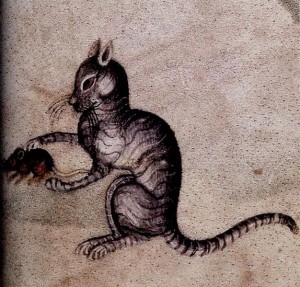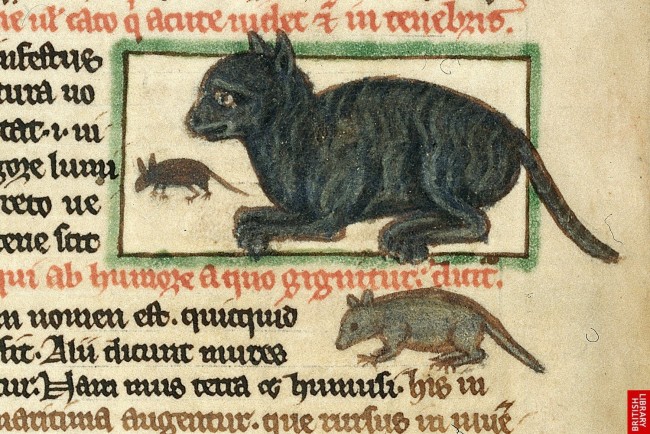Through Golden Eyes |
- ‘Cat Whisperer’ Mieshelle Nagelschneider & ‘Cat Daddy’ Jackson Galaxy Join Forces for Stray Cat Alliance
- The Medievel Cat
- Image of the Day
| Posted: 03 Oct 2013 07:10 AM PDT Stray Cat Alliance Notice I said "stray" and not "feral cat" population, as the problem demographic seems to be comprised of stray animals here in Los Angeles, according to the cat rescue and advocacy organization, Stray Cat Alliance. By helping to reduce the overpopulation of stray cats through owner and would-be owner education and more directly by neutering (removing reproductive organs of either gender) adult and sub-adult cats, Stray Cat Alliance is profoundly mitigating potential concerns associated with an overwhelmingly large free-roaming population of stray cats. The organization not only prevents recruitment of strays into feral populations, which are more challenging to deal with, and the birth of unwanted litters through humane intervention, but it provides permanent and foster homes for strays. To top it off, Stray Cat Alliance works anywhere there is a need. This includes low income neighborhoods, which may require the most attention. In such areas, clientele and other residents may be entirely unaware or, at least, incapable of employing responsible measures to care for an already overwhelming number of domestic felids out "on the prowl." But she and her staff and hundreds of volunteers have more ambitious plans. They hope to not only build a "no kill" city, but become a model for other metropolitan areas in hope of building a "no kill" nation; and they are doing it one stray at a time for a huge stray cat population, which is commensurate with a city as large a size as Los Angeles. It's a big problem. (Stray Cat Alliance) Animal advocacy groups like the Stray Cat Alliance are ardent supporters of Trap, Neuter and Return (TNR). This method of population control is considered quite humane and supports the "no kill" agenda of Stray Cat Alliance and complements the organization's rescue efforts. Some wildlife conservationists argue that TNR programs have limitations as a measure for controlling stray and feral cat populations. Their concern is that the practice may not adequately address issues more peripherally related to population control, like the impact free-roaming domestic cats have on veterinary public health and human health in terms of communicable disease transmission, or the impact cats may have on wildlife populations. Christi Metrople, Executive Director of Stray Cat Alliance A recent study suggests that vasectomized or hysterectomized (TVHR) cat populations are even less sustainable or easier to extinguish than TNR populations. In fact, in a blog post summarizing the study, Nat Geo News staff writer Christine Dell'Amore reported the following: This is promising news. However, in that same post, Christine reported that "Sheilah Robertson of the American Veterinary Medical Association's Animal Welfare Division also noted that "it's unlikely a single tactic will be a cure-all" for the feral-cat problem." I myself, a wildlife conservationist, am writing a book about the unfortunate plight of black cats—animals that often end up the last to leave shelters, if they leave at all. I've always been enamored with the "big cats," but more recently I acquired an affinity for "house" cats, especially black cats—the true underdog. Many are euthanized because no one ever rescues them. Black Cat Rescue in Boston, like Stray Cat Alliance in Los Angeles, is praised by cat enthusiasts. Like the Stray Cat Alliance, they are finding homes for otherwise unwanted animals and making critical contributions to cats in need of homes and capable of being helped. Black cats, in particular, have suffered greatly for centuries at the hands of humans. They have been abused and outright tortured. Their story has been likened to the Holocaust. And it has moved me beyond words. I may have been born a "dog" person and as a zoologist I studied bears—and I guess I've to become a "bear" person. With that said, learning of the persecution of black cats over a period of centuries has facilitated my conversion to a "crazy cat guy." And after learning how many black cats have been euthanized because of a larger issue of overpopulation, I can't go back. An outrageous number of pets have been overlooked and neglected with respect to responsible cat ownership. Black cats continue to be abused due to the persistence of pure mythology, but all cats suffer when their human caretakers act irresponsibly.  Special guests will include internationally renowned cat behaviorists Mieshelle Nagelschneider and Jackson Galaxy of Animal Planet's My Cat From Hell. In my back cover review for Mieshelle's scholarly-cited book The Cat Whisperer, which she co-wrote with Cameron Powell, I shared the following: I would add that it was Mieshelle who inspired my "cat fancy" and taught me that feline companions, now outnumber canine companions as our favorite pets. I also look forward to meeting Jackson Galaxy (AKA Cat Daddy) and picking his brain for some insider cat knowledge. Barbi Twins Mieshelle Nagelschneider Sandra Taylor (Wikipedia) Past guests include the likes of celebrity animal activists, the Barbi Twins and other public figures dedicated to helping companion animals. Last year's event was extremely well attended and was held at the home of Cheri Shankar, a council member of the HSUS, and her husband Naren, the Executive Producer/Writer of the television show CSI. This year's event is expected to draw even more celebrity animal activists and enthusiasts to champion a cause for cats, including the Barbi Twins and actress/model Sandra Taylor.  (Range of Domestic Cat) NGS The following excerpt was taken from the National Geographic Society webpage on domestic cats:"Domestic cats, no matter their breed, are all members of one species.Felis catus has had a very long relationship with humans. Ancient Egyptians may have first domesticated cats as early as 4,000 years ago. Plentiful rodents probably drew wild felines to human communities. The cats' skill in killing them may have first earned the affectionate attention of humans. Early Egyptians worshiped a cat goddess and even mummified their beloved pets for their journey to the next world—accompanied by mummified mice! Cultures around the world later adopted cats as their own companions. (Nat Geo Archives) They are particularly effective at night, when their light-reflecting eyes allow them to see better than much of their prey. Cats also enjoy acute hearing. All cats are nimble and agile, and their long tails aid their outstanding balance. Cats communicate by marking trees, fence posts, or furniture with their claws or their waste. These scent posts are meant to inform others of a cat's home range. House cats employ a vocal repertoire that extends from a purr to a screech. Domestic cats remain largely carnivorous, and have evolved a simple gut appropriate for raw meat. They also retain the rough tongue that can help them clean every last morsel from an animal bone (and groom themselves). Their diets vary with the whims of humans, however, and can be supplemented by the cat's own hunting successes." -National Geographic Society
|
| Posted: 03 Oct 2013 06:45 AM PDT Why Cats were hated in Medieval EuropeCats in medieval Europe mostly had a bad reputation – they were associated with witches and heretics, and it was believed that the devil could transform himself into a black cat. In her article, "Heretical Cats: Animal Symbolism in Religious Discourse," Irina Metzler looks at how this view of felines emerged. Cats filled one very important role for humans in the Middle Ages – they caught mice, which would have otherwise been a serious nuisance for people and their food. However, medieval writers even saw this activity in negative tones, often comparing the way cats caught mice with how the devil could catch souls. For example, William Caxton wrote "the devyl playeth ofte with the synnar, lyke as the catte doth with the mous." By the twelfth-century this association with the devil became even more ingrained. Around 1180, Walter Map explained in one of his works that during satanic rituals "the Devil descends as a black cat before his devotees. The worshippers put out the light and draw near to the place where they saw their master. They feel after him and when they have found him they kiss him under the tail." Heretical religious groups, such as the Cathars and Waldensians, were accused by Catholic churchmen of associating and even worshipping cats. When the Templars were put on trial in the early fourteenth-century, one of the accusations against them was allowing cats to be part of the services and even praying to the cats. Witches too, were said to be able to shape-shift into cats, which led to Pope Innocent VIII declaring in 1484 that "the cat was the devil's favourite animal and idol of all witches."  Metzler believes that the independent nature of cats was the source of this anxiety from humans. Medieval people generally believed that animals were created by God to serve and be ruled by humans, but the cat, even when domesticated, cannot be trained to be loyal and obedient like a dog. Edward, Duke of York, writing in the early fifteenth-century, summed up what many medieval people must have thought: "their falseness and malice are well known. But one thing I dare well say that if any beast has the devil's spirit in him without doubt it is the cat, both the wild and the tame." Metzer writes: Medieval people may have wanted to restrict cats to the function of animated mousetraps, for the very reason that the cat "stands at the threshold between the familiar and the wild." "Cats were intruders into human society. They could not be owned. They entered the house by stealth, like mice, and were suffered because they kept the insufferable mice in check." This causes a kind of conceptual tension. While the cat possesses the characteristics of a good hunter it is useful, "but as long as it does it remains incompletely domesticated." Heretics, too, in a transferred sense, are not completely domesticated, since by challenging orthodox thought and roaming freely hither and thither in their interpretation of religious beliefs they resemble the bestiary definition of wildness. As symbolic animals,them, cats may be the heretical animal par excellence. Not all medieval Europeans hated cats. There are many accounts of cats being kept as pets, including by nuns. Moreover, medieval Muslims were very fond of cats. A few accounts from early Islam suggest that the Prophet Muhammad and other figures liked cats and treated them well. Perhaps the cleanliness of cats was highly appealing to Muslims. In medieval Middle Eastern cities you could even find charities that took care of streets cats. One European pilgrim who traveled to the Middle East even noted that among the differences between Muslims and Christians was that "They like cats, while we like dogs." Metzer's article, "Heretical Cats: Animal Symbolism in Religious Discourse," appears in Medium Aevum Quotidianum Vol. 59 (2009). Irina Metzler teaches at Swansea University. You can find her personal website here. source |
| Posted: 03 Oct 2013 06:31 AM PDT |
| You are subscribed to email updates from Through Golden Eyes To stop receiving these emails, you may unsubscribe now. | Email delivery powered by Google |
| Google Inc., 20 West Kinzie, Chicago IL USA 60610 | |












No comments:
Post a Comment